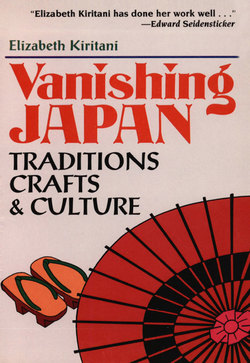Читать книгу Vanishing Japan - Elizabeth Kiritani - Страница 9
ОглавлениеCandy Animals
You may get a peek at an amezaiku (candy artisan) this summer, if you're lucky. The remaining few are being hired for private parties, so running into one in the street is quite an event. But they still appear at some of the big festivals. Tokyo's top candy virtuoso, Ki Aoki, always has a stall at the Yasukuni Shrine for its Obon (July 13-16) and New Year (December 30-January 4) festivals.
I located him this year by the boisterous cluster of school girls in yellow backpacks and straw hats surrounding him. "Make a swan, make a koala," they shouted. As Mr. Aoki made the animals, he told jokes. One little girl was holding a large bag against her chest. "Moving, are ya?" he quipped. The kids tittered. "You'd better go home now (they are en route from school). Bring your mother or grandfather with you tonight and I'll show you some more." The old sales pitch.
But Mr. Aoki's best customers aren't kids. They're OLs (office ladies) in their twenties. "The kids have no time to come back. They're on schedules," he explains. According to his wife, prices haven't changed much over the years. They range from 300 yen for a simple rabbit (usagi) to 1,500 yen for a raccoon dog (tanuki) with the standard hat and accessories. Most of the items he crafts cost 500 yen.
A tradition said to have started in Osaka in the early 1800s, candy-animal making requires more skill than is apparent. Just preparing the candy is tricky. Glutinous rice (mochi gome) and potato powder are boiled carefully to a specific transparent doughy texture, and then hand pulled and kneaded. Contact with the air during this process produces the pure white color. It is then rolled into a huge ball and allowed to harden until ready for use.
Tadon (charcoal) in the box of the amezaiku's cart heats the large candy ball into a pliable mass. Animals must be formed quickly before the candy hardens—a rabbit, for instance, takes about thirty seconds. Dexterity, an artistic sense, and a lot of imagination are needed.
The challenge is to find an animal or bird that Mr. Aoki can't make. The last of the experienced amezaiku in Tokyo, he keeps up with comic and cartoon animals as well as regular bird and animal species. Doves, unicorns, Australian lizards, welcoming cats, and, most difficult of all, dragons are standard items. He scoops a wad of hot white candy in his hand, rolls it into a ball, and snips it here and there with razor-sharp tweezer-scissors to make his specialty: the intricate fanned wings of a crane.
Hooked around his middle finger and extending back over his forearms are his tekko. These decorative cloth coverings serve as sweat guards. The work is hot. During his thirty years of experience, Mr. Aoki has had a number of apprentices, but all quit before they had learned the trade. "The candy burns your hands. It's painful and hard to get used to." The miniature scissors are also dangerously sharp. Although lucrative private parties have sparked new interest in the occupation in Tokyo, the difficulty of the work has kept the number of amezaiku down to less than ten.
One thing Mr. Aoki won't make is a frog. Whenever he makes a frog it starts to rain. "Ame (rain) is not good for the ame (candy) business," he jokes.
A hachimaki (cloth headband) is twisted around Mr. Aoki's forehead and he's wearing a navy happi coat with a donburi in place of a shirt. This donburi is a short indigo apron with a large kangaroo pouch in front. You see it at all festivals. Mr. Aoki's pants are tight momoshiki, also festival garb. His lively wife, Eiko, his assistant for twenty years, is dressed in indigo as well. She cools the animals in front of a fan to set their shape before applying an assortment of red, yellow, and green colors.
"Many of the animals used to be blown like glass," she says, "but this was prohibited around 1973 for hygienic reasons. Now if you want to make a blown one, the customer must blow it himself or, as in Kansai, a rubber pump is used."
What do they taste like? I don't know. You buy one and see if you have the heart to eat it.
